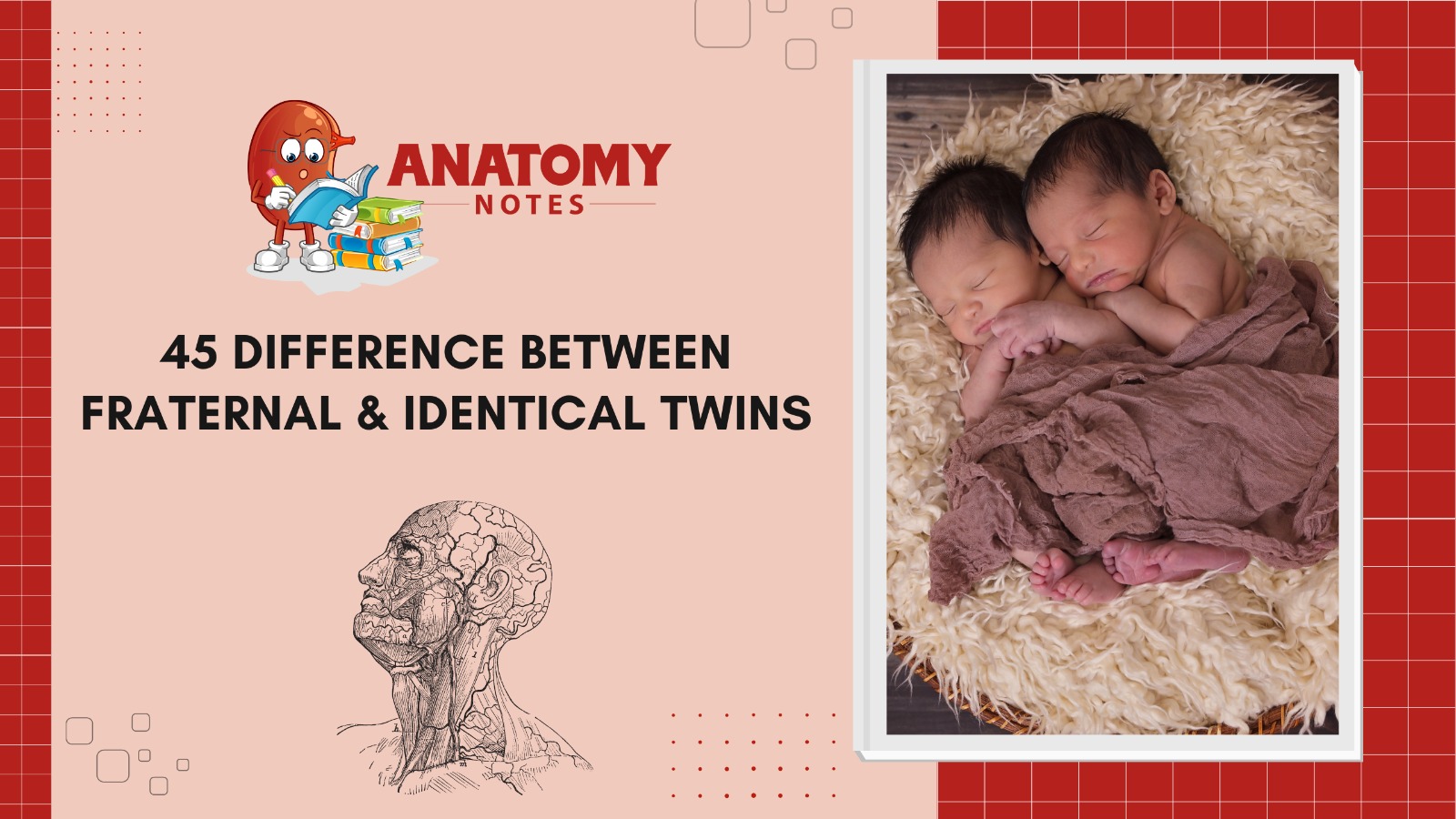Because twins’ DNA and growth differ, scientists, researchers, and the public have always been fascinated by them. Different genetics and physical traits distinguish fraternal and identical twins. Knowing the distinctions between these twins can help you understand how genes and the world interact.
Fraternal twins, also known as dizygotic twins, are created when two eggs are fertilized simultaneously. Fraternal twins might have the same or different sexes and look like any other pair of cousins. These twins were born from several eggs discharged and fertilized in one ovulation cycle. The mother’s age, inherited variables, and fertility treatments increase the likelihood of fraternal twins.
However, monozygotic twins begin as one fertilized egg that separates into two infants. They are genetically similar because they share practically all of the same DNA. All identical twins are the same gender and appear alike. Environmental factors can cause modest changes in development. Scientists are still investigating what causes one egg to break into two, resulting in identical twins.
Identical twins generally share more emotions and thoughts. This is frequently dubbed “twin telepathy,” but there is little scientific proof. Through shared experiences and growing very close, fraternal twins may connect differently than other brothers.
Race and family heritage impact the likelihood of having fraternal or identical twins. Fraternal twins depend on the mother’s age. More eggs are released by older mothers. However, identical twins are frequent regardless of the mother’s age. In conclusion, DNA, growth, and thought distinguish fraternal and identical twins. Two eggs fertilized together produce fraternal twins, who share roughly half their DNA.
Identical twins are formed when a single infant separates into two. Due to these variances, the two sorts of twins may have distinct mental ties and appear different. Twinning’s effects on human genetics and development are still being studied.
|
No. |
Aspect |
Fraternal Twins |
Identical Twins |
|
1 |
Origin |
Develop from two separate eggs |
Develop from a single fertilized egg |
|
2 |
Genetic Makeup |
Share about 50% of genetic material |
Share nearly 100% of genetic material |
|
3 |
Placenta and Amniotic Sac |
Can have separate or shared placenta/sac |
Often share placenta/sac, with variations |
|
4 |
Gender |
Can be same or different genders |
Always same gender |
|
5 |
Zygosity Testing |
DNA testing confirms non-identical |
DNA testing confirms identical |
|
6 |
Fertilization |
Two separate fertilization events |
|
|
7 |
Genetic Differences |
Different genetic combinations |
Same genetic makeup |
|
8 |
Chorionicity |
May have different chorionicity |
Chorionicity can vary |
|
9 |
Timing of Division |
Develop from separate fertilizations |
Division of single fertilized egg |
|
10 |
Fetal Membranes |
Often have separate sacs/chorions |
May share or have separate sacs/chorions |
|
11 |
Chromosomal Differences |
Different combinations of chromosomes |
Have identical chromosomal combinations |
|
12 |
Genetic Similarity |
Similarity similar to any siblings |
Genetically identical |
|
13 |
Number of Eggs Fertilized |
Two eggs fertilized by two sperm |
One egg fertilized, then split |
|
14 |
Twinning Rate |
More common in older women and genetics |
Occur randomly and at a consistent rate |
|
15 |
Fertility Treatments |
Can result from fertility treatments |
Can also result from fertility treatments |
|
16 |
Genetic Testing |
Show different DNA profiles |
Show identical DNA profiles |
|
17 |
Physical Resemblance |
Resemble each other like siblings |
Can look extremely alike |
|
18 |
Shared Placenta Complications |
Lower risk of shared placenta issues |
Risk of shared placenta complications |
|
19 |
Twin-to-Twin Transfusion Syndrome |
Less likely to develop TTTS |
Higher risk of developing TTTS |
|
20 |
Chances of Multiples in Future |
Slightly increased chance of multiples |
Same chance as any other pregnancy |
|
21 |
Identical Genetic Markers |
Differ in genetic markers |
Share the same genetic markers |
|
22 |
Amniotic Fluid Levels |
Can vary independently in each sac |
Levels might be similar due to shared sac |
|
23 |
Separation in Utero |
Separate embryos from conception |
Split from a single embryo |
|
24 |
Inherited Disorders |
Share 50% of genes, similar risk |
Identical genetic risk for inherited issues |
|
25 |
DNA Methylation Patterns |
May show differences in epigenetics |
Usually share similar DNA methylation |
|
26 |
Chances of Down Syndrome |
Different risk as separate fertilizations |
Same risk due to shared egg origin |
|
27 |
Chances of Conjoined Twins |
Different risk due to separate origins |
Same risk due to shared origins |
|
28 |
Mirror-Image Twins |
Can result in mirror-image twins |
Can be mirror images of each other |
|
29 |
Hormone Levels |
Hormone levels vary in separate pregnancies |
Hormone levels are shared |
|
30 |
Twinning after Twins |
Can give birth to a set of twins again |
Extremely rare due to shared origin |
|
31 |
Gestational Age Differences |
Might have different gestational ages |
Usually have the same gestational age |
|
32 |
Umbilical Cord Arrangement |
Independent cord arrangements |
Shared cord arrangements |
|
33 |
Chances of Genetic Mutations |
Different mutation risks |
Same mutation risk due to shared genetics |
|
34 |
Fetal Competition |
Less fetal competition for resources |
More competition for resources |
|
35 |
Fetal Interactions |
Interact similarly to non-twin siblings |
May have unique in utero interactions |
|
36 |
Hereditary Traits |
Share some, not all hereditary traits |
Share all hereditary traits |
|
37 |
Blood Type Differences |
Can have different blood types |
Usually have the same blood type |
|
38 |
Dominant/Recessive Traits |
Differences in trait inheritance |
Inherit dominant/recessive traits alike |
|
39 |
Birth Order |
Different birth orders |
Always have the same birth order |
|
40 |
Weight and Size Differences |
Varied sizes and weights |
Often have similar sizes and weights |
|
41 |
Twinning Environments |
May develop in different environments |
Develop in the same uterine environment |
|
42 |
Hereditary Diseases |
Different risk for hereditary diseases |
Same risk for hereditary diseases |
|
43 |
Twinning Factors |
Influenced by genetic and environmental factors |
Influenced by genetic factors |
|
44 |
Embryonic Development |
Separate embryos with individual progress |
Share embryonic development |
|
45 |
In Vitro Fertilization |
Can result from IVF treatments |
Can result from IVF treatments |
Frequently Asked Questions (FAQ)
Q.1 What are fraternal twins and how do they form?
When two mothers’ eggs are fertilized by two distinct sperm cells, dizygotic twins are born. Like siblings born at separate periods, these twins share 50% of their DNA. Genetics, mother age, and fertility procedures affect fraternal twins.
Q.2 What makes identical twins different from fraternal twins?
One fertilized egg splits into two embryos, creating monozygotic twins. These twins are genetically similar. Unlike fraternal twins, who can be either gender, identical twins are always the same and typically look alike.
Q.3 Are identical twins alike?
Due to environmental and life circumstances, identical twins might have different personalities. Upbringing, education, and relationships shape their identities.
Q.4 Is "twin telepathy" real?
“Twin telepathy,” when twins seem to have a psychic link, fascinates and divides. This phenomenon lacks scientific proof. Twins may feel close or intuitively understand one another due to their common upbringing and strong affinity.
Q.5 Are identical twins medically different?
Identical twins might have diverse medical histories. Environmental influences, lifestyle choices, and developmental variances might affect health outcomes. Genetics and environment affect health, as one twin may acquire problems the other does not.
Q.6 What affects twin births?
Several variables affect twinhood. Older women produce more eggs at ovulation, increasing the likelihood of fraternal twins. Family history matters, especially for fraternal twins. IVF increases the odds of conceiving fraternal and identical twins.




